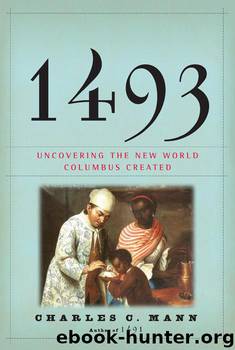1493 by Charles C. Mann

Author:Charles C. Mann
Language: eng
Format: mobi, epub
Tags: History
ISBN: 9780307596727
Publisher: Knopf
Published: 2011-08-01T00:00:00+00:00
Sugar mills were smoky, steamy places that required many workers, as shown in this engraving of a Sicilian mill around 1600 (it is based on a painting by Jan Van der Straet, a Flemish artist active in Florence). (Photo credit 8.3)
Two key elements, though, were missing: the organisms responsible for malaria and yellow fever. Both were abundant in São Tomé and Príncipe, two islands in the Gulf of Guinea that Portugal took over in 1486. Like Madeira, they were uninhabited, thickly forested places with a warm climate, good volcanic soil, and plenty of water—perfect for producing C12H22O11. Like Madeira, they were settled by entrepreneurially minded petty nobles who hoped to cash in on Europe’s sweet tooth. Unlike Madeira, though, São Tomé and Príncipe swarmed with Anopheles gambiae, Africa’s worst malaria carrier; and Aedes aegypti, which transmits yellow fever. It was a bit like a natural scientific experiment: change one variable and see what happens.
The first two, small movements into São Tomé failed—killed off by disease. A third, larger attempt in 1493 succeeded, partly because it was accompanied by a mass of slave labor: convicts and undesirables, notable among the latter some two thousand Jewish children who had been taken forcibly from their parents. Sugar planters and sugar processors, criminals and children—all died in droves. After six years, only six hundred of the children were alive. Nonetheless the colony somehow kept going. A Dutch force landed in 1599 on Príncipe, the second island, intending to transform it, too, into a sugar center; the invaders departed after just four months, leaving more than 80 percent of their men beneath the ground. A year later the Dutch tried a different tactic: occupying São Tomé itself. Two weeks and 1,200 dead Dutchmen later, they bolted. Europeans perished with such routine dispatch on the islands that the Portuguese government took to exiling troublesome priests there, thus ensuring their deaths while technically avoiding the Vatican’s ban on executing its functionaries. In 1554, six decades after colonization began, São Tomé had but 1,200 Europeans. By 1600 the figure had shrunk to about two hundred—slaves outnumbered masters by more than a hundred to one. In 1785 an official report claimed that just four people—four people!—of pure European stock lived on the island. Trying to build up the colonial population, the monarchy ordered that female African slaves be awarded to every new male European arrival, along with exhortations to breed. The ploy failed to boost the number of migrants—the risk was not worth it. Even the bishops the Vatican appointed to the island refused to come. After the post had been vacant for forty-three years, a new bishop finally had the courage to land in São Tomé in 1675. He was dead in two months. “In São Tomé, there’s a door to come in,” the Portuguese sang, “but there’s no door to go out.”
Despite the lack of colonists the colony flourished—for a while. At the height of the boom São Tomé exported four times as much sugar as Madeira.
Download
This site does not store any files on its server. We only index and link to content provided by other sites. Please contact the content providers to delete copyright contents if any and email us, we'll remove relevant links or contents immediately.
| African Americans | Civil War |
| Colonial Period | Immigrants |
| Revolution & Founding | State & Local |
Cat's cradle by Kurt Vonnegut(13921)
Pimp by Iceberg Slim(12966)
Underground: A Human History of the Worlds Beneath Our Feet by Will Hunt(11284)
4 3 2 1: A Novel by Paul Auster(11094)
The Radium Girls by Kate Moore(10939)
American History Stories, Volume III (Yesterday's Classics) by Pratt Mara L(4832)
Perfect Rhythm by Jae(4640)
Wiseguy by Nicholas Pileggi(4624)
The Fire Next Time by James Baldwin(4363)
Paper Towns by Green John(4188)
A Higher Loyalty: Truth, Lies, and Leadership by James Comey(4051)
Pale Blue Dot by Carl Sagan(4031)
The Mayflower and the Pilgrims' New World by Nathaniel Philbrick(3927)
The Doomsday Machine by Daniel Ellsberg(3748)
Too Much and Not the Mood by Durga Chew-Bose(3707)
Killers of the Flower Moon: The Osage Murders and the Birth of the FBI by David Grann(3648)
The Borden Murders by Sarah Miller(3601)
The Sympathizer by Viet Thanh Nguyen(3540)
Killing England by Bill O'Reilly(3473)
